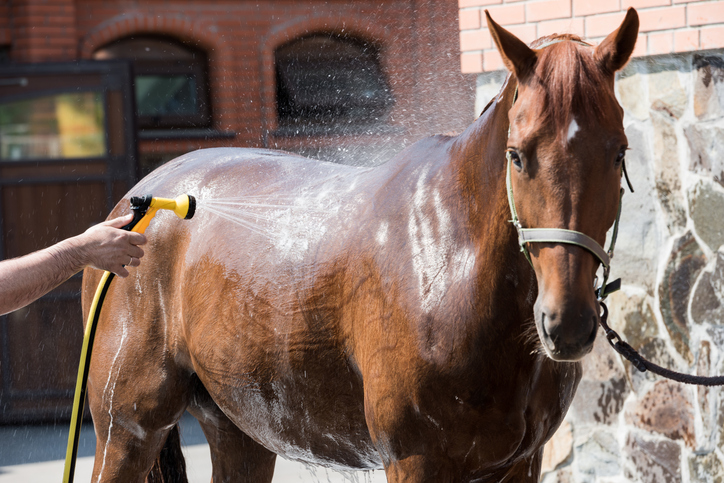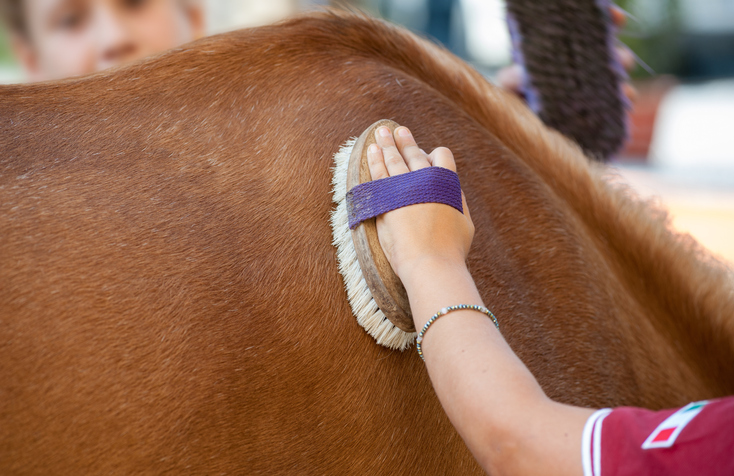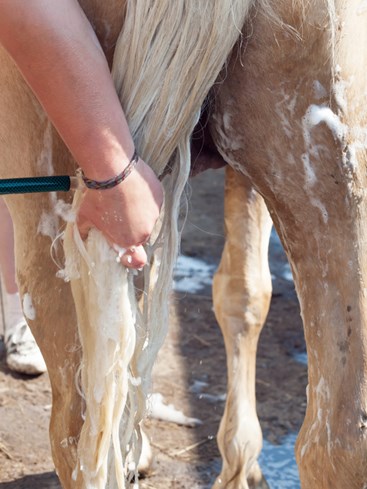A glossy-coated horse cantering across a field with the wind in its mane is a sight that gladdens the heart of any equestrian.
However, keeping your horse or pony clean is not just about maintaining its good looks – it’s essential to its health, too. And bathing a huge horse is no easy feat, especially if your animal is apprehensive or you’re inexperienced.
So where should you begin, and what tips and tricks can make this task easier for you? And above all, how can you keep yourself and your animal safe during its bath?
Read on for our guide to washing your horse. And remember – no matter how careful or experienced you are, accidents can happen, so make sure you’re covered with horse rider insurance.
Why wash your horse?
Horses seem to love mud. Whether it’s from trekking, jumping or just rolling on the grass of their paddocks, even the most dignified of thoroughbreds will accumulate a splattering of dirt on an all-too-frequent basis.
So keeping your horse clean can seem like a never-ending chore. But it is a vital one.
Most importantly, there are good health reasons. Dried sweat, dust or dirt can irritate the horse’s skin and cause the animal to rub its mane and tail. And if your horse has rolled in manure, it could pick up parasites.
An uncomfortable horse is more likely to try to throw its rider, too. Horse rider insurance may cover the cost of accidental injury, but a good bath might just prevent them from occurring in the first place!
Your horse might also need a bath if it’s picked up a skin condition such as rain rot or ringworm that requires treatment with medicated shampoo. Ask your vet for advice.
If you enter your horse into competitions, it’s essential that you ensure it’s in tip-top condition, gleaming from nose to tail.
And finally, many horses love a refreshing shower as much as we humans do, particularly on a hot day or after vigorous exercise. So washing your horse can be a great way for you to treat your animal and enjoy some great bonding time together.

-
Pick a good time
Washing a horse is not a chore to be undertaken lightly! So make sure the time is right.
First of all, you need to consider how often your horse needs a bath. The main way to keep it clean is through grooming, which you should be doing at least a few times a week. Many owners simply supplement that grooming routine with spot cleaning, tail shampooing, and wiping their animal with a damp cloth – they rarely give their horse a proper bath. Others simply give their equines a regular rinse with a hose, while still others have a weekly bath routine for all the animals in their stables.
If you think it’s about time your horse had a proper clean, take a look at the weather forecast. It’s best not to choose a cold or rainy day if you can avoid it.
Then consider whether you have the time to spare. You’ll need a couple of hours to brush, wash and dry your animal, and patience is key.
Finally, pick a moment when your horse is relaxed, especially if this is the first time you’ve bathed it.
-
Get your equipment together
Now get everything you’ll need ready – you don’t want to be shopping for shampoo mid-bath!
You’ll need the following cleaning equipment as a minimum:
- Grooming brushes and combs
- A step stool
- A bucket and hose
- A scrubbing sponge or sponge mitt
- Soft sponges
- Horse shampoo
- A scraper
- Towels and cloths
If you’re aiming to get your horse show-ready, you might want other products, too, such as blue shampoo for any white areas, tail detangler spray and coat polish.
You’ll also need to tie your horse using a quick-release knot, or have a helper to hold the reins.
-
Give it a good brush
Once you’ve got your horse ready and waiting, you need to follow your usual grooming routine to loosen any mud or dirt.
That also relaxes your horse, and gives you time to check for any skin irritations or other issues.

-
Wet your horse with lukewarm water
This is the moment of truth! Gently, use your hose to wet all of the horse’s body except its head.
Unless you already know that your horse loves baths, it’s best to take it slowly. Start from the hooves and work your way slowly upwards, avoiding the face. This gives your horse time to adjust, so it’s less likely to be spooked.
Use a gentle jet of water, and take extra care around sensitive areas such as under the tail. If your horse really hates being hosed down anywhere, you can switch to wet sponges or buy a ‘wash wand’ that produces a gentler spray.
Remember: don’t stand directly behind your horse at any moment in case it startles and kicks. Horse rider insurance may provide cover for accidental injury to you or your horse, but you want to avoid this situation if at all possible.
-
Shampoo the body and legs
Now you need to work up a lather! Add some shampoo to your bucket of warm water, and soak your scrubby sponge in it.
Then apply to your horse’s hair, starting behind the ears. This is where your step stool comes in handy! Work your way down one side of the body, right down the legs.
Use a circular motion to work the suds into the hair to get to the dirt on the skin.
Once you’ve finished one side, repeat the process on the other. It might be a good idea to change the water in the bucket first if it’s looking dirty.
-
Shampoo the face
Still using your scrubby sponge, apply suds carefully to your horse’s face.
You’ll need to pay extra attention to its forelock and the hair around its ears and eyes – but make sure you don’t get shampoo in its eyes.
Wipe the backs of its ears with the sponge, but take care not to drip water into them – most horses hate this feeling. Avoid getting water in the nostrils, too.
-
Turn to the tail and mane
It’s essential that you give the tail and mane a good clean, as they are dirt and dust magnets.
You can lift up the bucket to dunk the tail in the sudsy water. Give it a good soak, and work the suds through from root to tip.
With the mane, you’ll need to work in the shampoo with your scrubby sponge. If it’s especially dirty, apply neat shampoo directly before tackling the area with the sponge.
-
Rinse your horse’s body, legs, mane and tail
Now it’s time to rinse the shampoo out of your horse’s coat. It’s really essential that you do this thoroughly, as residual shampoo can irritate your horse’s skin as well as make its coat look dull.
Plus, if your horse learns to associate bath-time with irritated skin, you’ll have trouble persuading it to undergo another wash in the future.
To rinse, you can use either the hose or a bucket of clean warm water with a clean, soft sponge.
Again, start at the shoulder and front legs. Move onto the neck and mane, then down one side of your horse’s body, not forgetting its belly. Repeat on the other side.
Lift the tail and use either a wet sponge or a very gentle jet around the hindquarters.
Hose or sponge the tail. Run your fingers through the hairs to check for any remaining soap suds, and give another rinse if necessary.

-
Rinse your horse’s head
This is probably the trickiest part of the entire operation. You need to get all the soap out to avoid irritating the skin – but you must also avoid dousing with water.
Instead, fill your bucket with clean, warm water; dunk in a fresh, soft sponge; then wring it out.
Step onto your stool and apply the sponge gently to the horse’s face. Remember to avoid the eyes, nostrils and ears.
Now go over the horse’s face again with a soapy sponge, giving any especially dirty areas another gentle scrub.
The last step is to change your water, soak another clean sponge, wring it out, then go over the horse’s face one final time. You can end by giving the nostrils a quick wipe, too.
-
Apply conditioner or treatments
If you want to show your horse, or if you notice that its coat, mane or tail are looking dull or worse-for-wear, you might like to apply extra treatments at this stage.
One common application is tail and mane conditioner. You’ll have to comb this in, leave it for 15 minutes, then rinse well.
-
Dry your horse
Use a scraper to clear away as much excess water as you can from your horse’s body. Start at its neck and work your way along the body, scraping in the direction of the hair growth.
Use a dry sponge to absorb water from the legs.
Towel dry the head and ears, then continue down the horse’s body. You will probably need several towels!
-
Apply finishing touches
Finally, there are some equine products designed to be left in rather than rinsed out. Detangling spray is one: simply spray it onto the horse’s tail and mane to make them easier to comb.
Another is coat polish – guaranteed to make your horse gleam. Just remember not to apply it to the saddle area, otherwise you might find your tack slipping and taking you with it! Horse rider insurance can provide cover for any accidental injury to you and your horse, or damage to your tack.
And that’s it! Your horse is now as fresh as a daisy, ready to dazzle the judges at its next event.
Untie it and walk it as it grazes, or keep it in the yard until it’s fully dry. It can be a good idea to blanket the horse afterwards to make sure it stays warm.
Whatever you do, don’t let your horse straight out into the paddock after its bath, or put it into a dirty stall. You’re pretty much guaranteed that it will seize the moment to roll around on the ground, undoing all your hard work!
Top tips
Most horses grow to love a good bath, especially on a warm day. But if yours is reluctant, here are a few tricks you can try to make the process pleasanter for you both.
- Put safety first. Stand at your horse’s head or side, not behind its legs. Wear your riding helmet, too. Horse rider insurance may cover the cost of any accidental injury to you or your equine.
- Wear old clothes and have a towel and change of clothes ready. It won’t just be your horse who gets a soaking!
- Get your horse used to a hose that is turned off. Lead it over the hose so it learns it’s nothing to be scared of.
- Use a damp rather than a soaked sponge at first, gradually increasing the amount of water your horse can feel.
- Don’t use too much shampoo – this only prolongs the amount of time it takes to rinse.
- Keep your horse occupied with a hay net while you bathe it.
- Offer lots of praise and reassurance throughout the process.
Get a quote from Equesure today
Horses are flight animals by instinct, and no matter how gentle their nature, they can cause accidental damage or injury when startled.
Whether you are a horse owner or just an occasional rider, horse rider insurance policies arranged through Equesure can offer personal accident cover up to a value of £10,000 for juniors and £20,000 for adults, plus personal dental cover of up to £1,750.
Policies can also cover emergency vet fees up to a value of £1,500 for accidental visible injuries.
Policies can be tailored to your individual requirements and budget. Optional extras include a legal helpline, saddlery and tack cover, and a premium waiver.
Contact Equesure today for a quote.
Policy benefits and features offered may very between insurance schemes or cover selected and are subject to underwriting criteria. Information contained within this article is accurate at the time of publishing but may be subject to change.






